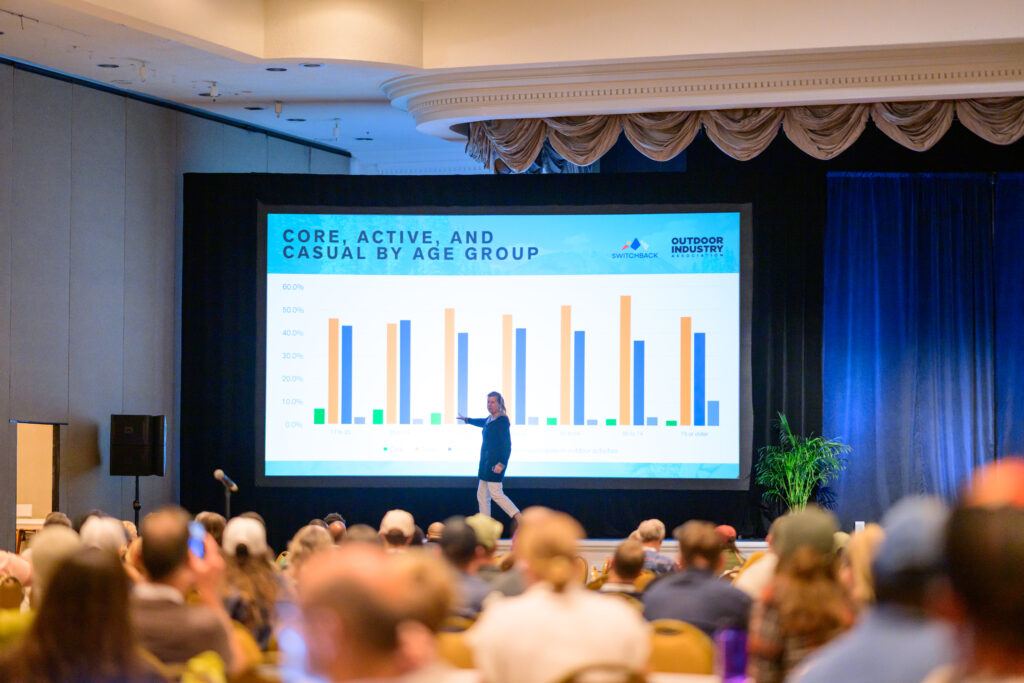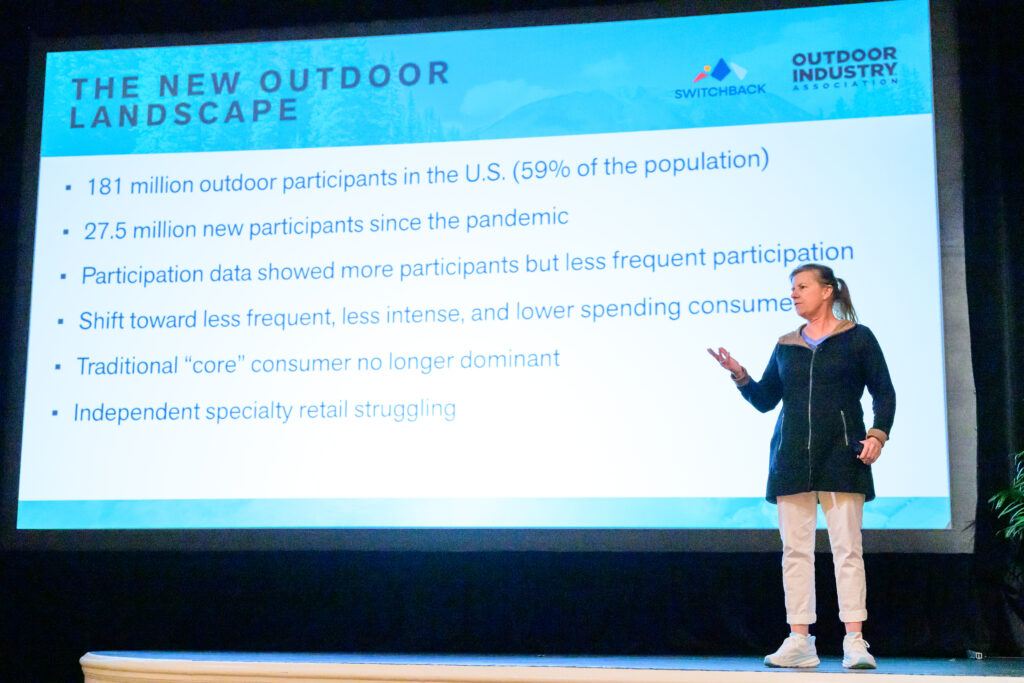Switchback Spring, June 16-18, 2026 in New Orleans, LA
•
Switchback at TRE, December 1-3, 2026 in San Antonio, TX

New research revealed at Switchback Spring 2025 shows an outdoor industry in flux with an increasingly diverse consumer base that includes more casual participants.
The 2025 Outdoor Participation Trends Report was produced by Outdoor Industry Association (OIA) and Outdoor Foundation, and OIA’s Research Director, Kelly Davis, shared highlights of the report during the conference.
Davis noted that the number of “core” outdoor enthusiasts in the United States grew by 5.7% in 2024; however, a growing majority of people participate in outdoor recreation only occasionally. In addition, these “casual” participants are seeking calm, peaceful outings rather than challenging, adrenaline-pumping adventures.
In addition to the growth of casual participants, the study notes, “There were significant increases in the number of youth and seniors, participants with more than 100K in annual income, participants in the South, participants with a high school diploma and no college education, and Black and Hispanic participants.”
Here are several key highlights from the Participation Report:
The number of outdoor recreation participants grew by 3% in 2024 and included 181 million people (58.6% of Americans). People participated in 11.8 billion outings, a statistic that has not changed since 2022.
Similar to past studies, the 2025 Outdoor Participation Report categorizes people as “casual,” “active,” and “core;” however, this year’s report included a new method of determining a person’s level of participation. Past studies measured only the frequency of participation, while the latest study considers the intensity of a person’s approach to an activity, noting whether someone is aggressive or casual. The report also assesses what a person aims to get out of the activity, whether someone is seeking excitement or something calmer.
 For decades, the outdoor industry has catered to hardcore outdoor enthusiasts, but new research signals that it should focus more on casual participants.
For decades, the outdoor industry has catered to hardcore outdoor enthusiasts, but new research signals that it should focus more on casual participants.
According to the report, “Today’s typical outdoor consumer participates in outdoor activities casually; they only get out occasionally, their approach is mild, not aggressive, and they are doing it to feel happy, calm, and balanced.”
According to the report, casual consumers comprise 42% of the market and go camping and hiking occasionally but rarely do anything intense. From 2023 to 2024, the number of casual customers each year was more than double the number of core participants and grew by about 10%.
Today, the typical participant spends less on outdoor products than people did in the past. Also, casual consumers are just as likely to shop on Amazon or at Dick’s Sporting Goods as they are likely to purchase from an outdoor specialty store.
While we’re seeing an influx of casual consumers, the base of core customers also grew in 2024. The number of core participants rose 5% to represent a little more than 30% of outdoor participants. The category includes 93.4 million people out of 181.1 million total participants.
According to the report, “The growth in core participants in 2024 was driven by a few specific cohorts, including 6% growth in participants aged 18 to 24 and 4.2% growth in participants aged 65 and older.”
In 2024, People of Color generated all the growth in core participation, including 11.4% growth in core Black participants, a 5.7% increase in core Hispanic participants, and a 2.1% increase in core Asian/Pacific Islander participants.
For decades, we’ve seen a decrease in the average number of outings per participant. The drop could be due to competition from electronic screens, social media, etc. In 2024, though, there was a 4.3% increase in the average number of outings. Why is this? The report speculates, “Maybe, in 2024, we saw some participants refocus their attention on outdoor activities to stay balanced and calm in a very chaotic day-to-day world?”
Looking to the future, participation frequency will be significantly affected by the actions of “household units.” If adults and kids are getting outdoors frequently, those family members will likely frequent the outdoors in the future. That being said, the report cautions, “Despite some growth in the overall frequency of participation, the declining frequency of outings in households with children aged 1 to 5 and 6 to 12 in 2024 is an indication that our fight to increase the frequency of participation is likely to be a long-term affair.”

The 2025 report indicates that older Americans are driving growth in outdoor recreation, noting, “Last year, 23.1 million Americans who were born before 1959 participated in outdoor activities, 1.6 million more than in 2023 and an astounding 11.3 million more than participated just a decade ago in 2015.”
Also, six years ago, the 65+ age group was the smallest age cohort in outdoor participation; however, in 2024, it was bigger than the cohorts for people 55 to 64, 45 to 54, 18 to 24, and 6 to 12.
While more older Americans are getting outdoors, the report also shows significant year-over-year growth in youth age groups. The report notes, “The 6- to 12-year age group grew 5.6% in both participation count and rate, rising to a record 75.5% of kids in that age group and adding 1.1 million new participants to the base.
For almost a decade, there’s been a steady increase in both the number of women and men participating in outdoor recreation.
According to the report, a record 53.2% of American females participated in outdoor recreation activities in 2024. That same year, American males also hit a high-water mark in their participation rate, at 64.3%.
In 2024, members of the transgender community represented less than 1% of participants.
Outdoor recreation is attracting a more diverse crowd these days, reflecting the growing diversity in the U.S. population.
Retailers and manufacturers should pay particular attention to members of the LGBTQ+ community. According to the report, “Participants who identify as Lesbian, Gay, Bisexual, Transgender, Queer or Questioning are the most active adult cohort in outdoor recreation.”
The LGBTQ+ community represents 11.4% of the outdoor participant base (20.6 million people), and that number grew by 700,000 participants from 2023 to 2024.
The findings in OIA’s Outdoor Participation Trends Report demonstrate that the consumer base is changing, and the outdoor industry must adapt to succeed in the future. The study also indicates the industry will be more likely to enjoy long-term success if it serves a broader spectrum of people.
Savvy companies will look beyond traditional audiences and address the diverse range of emerging communities driving participation, including groups that are often marginalized. As the study shows, People of Color were solely responsible for the growth in the core market, while we also saw increasing participation with women and members of the LGBTQ+ community.
The report ends on an optimistic note, concluding, “These trends signal meaningful opportunities for the outdoor industry to evolve, embrace new audiences, and build a more resilient future.”
When a person sees someone that is relatable to them participating in outdoor recreation and notices they are finding happiness, community, balance, and excitement, then they are more likely to participate themselves.



